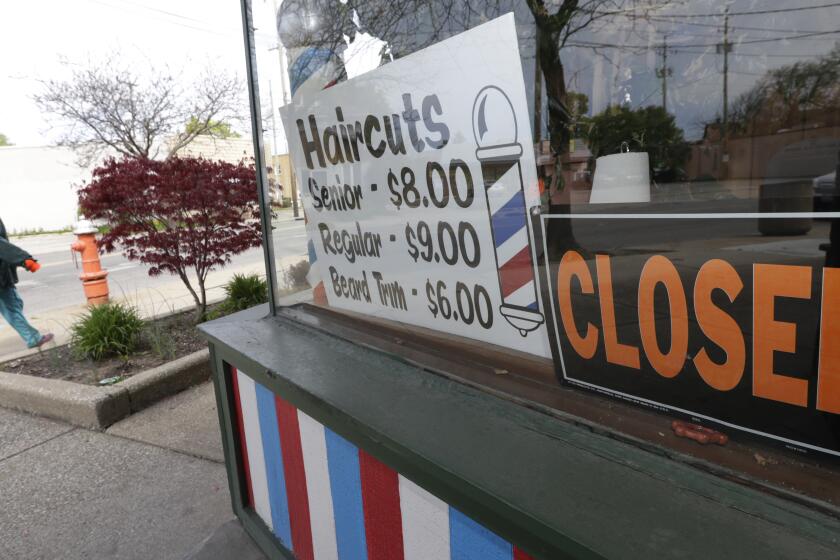Opinion: Fentanyl could fuel another cycle of loss in L.A.’s Black communities. It doesn’t have to

- Share via
The death of a parent is typically a gutting and disorienting experience for adults. For a child, it’s even worse, stoking feelings of frustration and abandonment and sometimes self-destructive behaviors such as drug use that can continue well into adulthood. This has particularly serious implications when the child is Black and therefore more likely to end up in the child welfare system.
A recent report by federal researchers provides the fullest picture yet of the sprawling impact of overdose deaths on Black children in Los Angeles and other cities — and what we can do about it.
From 2011 to 2021, the report found, more than 321,000 American children lost a parent to a drug overdose. Black children experienced the highest increases in the rate of such losses during those years, compounding a long-standing public health crisis across Black America. Like much of the United States, Los Angeles has seen drug overdoses soar in recent years, with disproportionate losses among the city’s Black adults.
When towns lose bowling alleys or movie theaters or libraries, they lose a safety net in the battle against addiction.
Black people are significantly more likely to experience drug-related deaths due to limited access to treatment and resources such as naloxone, which can reverse overdoses. When they’re parents, the toll on their children is both rapid and deep. Parental drug use is highly associated with use among children.
Although Black children make up just 7.4% of the Los Angeles County population, they represented 24% of those who entered the child welfare system in one recent year. One study found that about 47% of Black children in California were the subject of a maltreatment investigation before the age of 18, with substance use accounting for 41% of the state’s child maltreatment cases.
The disproportionate number of Black children in Los Angeles’ child welfare system has been scrutinized since the late 1980s, the height of Los Angeles’ heroin and crack epidemics. The drugs, then largely addressed as a criminal issue through heavy-handed policing and prosecution, consigned a generation of young and middle-aged Black Angelenos, both users and dealers, to premature death and incarceration. Many of their children wound up in the city’s fragmented child welfare system and, all too often, on a similar path toward addiction and entanglement with the legal system.
Overuse of pills contributes to misuse, addiction and diversion. Behavioral science points the way toward changing that.
When a child’s parent dies, other family members — the child’s other parent, grandparents, aunts or uncles — are the first resort to assume responsibility for their care. But Black children, especially those from low-income communities, often end up in the child welfare system instead.
Why? The child’s surviving family members may lack the resources to fill the breach. But racial biases also predispose child welfare workers to remove Black children from their families and impede reunification efforts.
Research has consistently shown that child welfare workers more readily define Black parents’ behavior as abusive or neglectful even when it’s comparable to the conduct of parents of other races. Child welfare workers are also more likely to regard Black families as less loving of their children and less redeemable.
Children who enter the child welfare system due to parental death already spend twice as much time in the system. Black children tend to remain in the system even longer because of bias.
The twin depredations of Los Angeles’ opioid epidemic and its child welfare system are daunting but not beyond repair. The first necessity is to revamp the city’s racially biased child removal process. Los Angeles officials have been piloting a “blind removal” approach in which investigations are followed by a decision-making process that excludes demographic details such as the child’s race. This is a step in the right direction.
However, a UCLA study of the pilot program revealed that racial disproportionality persists, demonstrating how deep-seated child welfare biases are. For blind removal to be effective in eliminating racial disparities, it must be supplemented by greater transparency, expanded civilian review boards and training in implicit bias.
Second, we need a better understanding of the consequences of placing Black children in the child welfare system. In general, Black children in the system are highly stigmatized, especially when they come from families with histories of drug abuse. That contributes to making them less likely to be adopted. The trauma of losing a parent also means they’re more likely to experience depression and anxiety.
These experiences frequently devolve into social isolation, poor academic outcomes, limited employment prospects and incarceration. Officials must work to identify these patterns early and provide resources such as mental health care to disrupt this harmful cascade.
Lastly, policymakers must continue to explore the benefits of guaranteed basic income to provide a cushion for personal and professional growth. Another California pilot program would provide guaranteed basic income to those who age out of foster care at 21 or older. The state should lower the eligibility age to 18 to account for the steep challenges in housing and employment Black youths face as soon as they become adults. Researchers at Stanford and other institutions have found that such policies support better health, housing security and employment prospects.
Addressing the deepening overdose epidemic in Los Angeles’ Black communities requires attention not just to the immediate risks to drug users but also to the childhood experiences that often drive them to use. One of our most powerful tools for preventing future overdoses is to take better care of the children most directly affected by today’s losses.
Jerel Ezell is an assistant professor of community health sciences at UC Berkeley who studies the racial politics of substance use.
More to Read
A cure for the common opinion
Get thought-provoking perspectives with our weekly newsletter.
You may occasionally receive promotional content from the Los Angeles Times.












